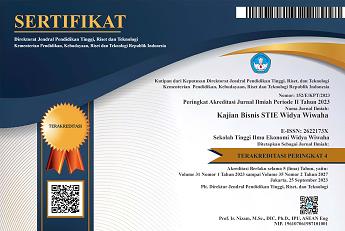PENGARUH FAKTOR MANFAAT DAN FAKTOR DEMOGRAFI TERHADAP LOYALITAS KONSUMEN OKID CAFE YOGYAKARTA
DOI:
https://doi.org/10.32477/jkb.v31i2.712Keywords:
Benefit factor, demographic factor, consumer loyaltyAbstract
This research was conducted to find out whether the benefits and demographic factors influence consumer loyalty in OKID Cafe Yogyakarta. This study uses an analytical tool in the form of multiple regression analysis by analyzing the influence of two independent variables on one dependent variable, while the two independent variables are the benefits factor (X1) and the demographic factor (X2) and the dependent variable is consumer loyalty (Y). from the results of the study using multiple regression analysis the following results were obtained Y = 7.306 + 0.228X1 + 0.609X2. From the two factors studied, the results obtained from calculations using the t test obtained results, namely the benefits factor is a factor that has a significant positive effect on consumer loyalty where t count (3.577greather than 1.660) with a probability of 0.000 below 0.5 which means Ho is rejected and Ha accepted and demographic factors have a positive effect on consumer loyalty (9.095greather than 1.665) with a probability of 0.000, which means Ho is rejected and Ha is accepted. Then from the two factors that were examined using the stepwise method, the result was that the benefit factor was the most dominant factor for the level of consumer loyalty in OKID Cafe Yogyakarta with a t value of 9.095 with a probability of 0.000. To find out how much the two independent variables influence the dependent variable, the results of the determination correlation analysis show that the two variables have an effect of 49.6 percent on the dependent variable and 50.4 percent are influenced by other variables.
References
Aditya Perdana Kusuma, (2020) Brand Management esensi posisi dan Strategi, Jakarta, Yayasan Kita Menulis
Algifari. 2009. Analisis Statistik untuk Bisnis dengan Regresi, Korelasi, dan Nonparametric. Edisi Pertama. Yogyakarta: BPFE.
Andriasan Sudarso, Ardhariksa Zukhruf Kurniullah (2020), Manajemen Merek, Jakarta, Bhineka Cipta
Arikunto. S., (2006), Prosedur Penelitian, Jakarta, Bhineka Cipta
Basu Swastha. (2017). Manajemen Penjualan. Yogyakarta: BPFE
Bayus. B. L., (2002), Brand Loyalty and Marketing Strategy: An Application to Home Appliances. Marketing Science-Marketing Journal of TIMS / ORSA, Vol. 11:21-37.
Biro Pusat Statistik, (2022), Data Penduduk Yogyakarta Menurut Golongan Umur, Daerah Perkotaan/Pedesaan, dan Jenis Kelamin, BPS Yogyakarta.
David Sukardi, (2020), Manajemen Merek dan Strategi E Commerce, Jakarta, Prenada Media
Dhannmesta.B.S. (1999), Loyalitas Pelanggan: Sebuah Kajian Konseptual Sebagai Panduan Bagi Peneliti, Jurnal Ekonomi dan Bisnis Indonesia, Vol 14:73-88.
Kotler dan Keller. (2009). Manajemen Pemasaran, Jilid I (ed 13). Jakarta: Erlangga.
Pike, S. 2008. Destination Marketing. Butterworth-Heineman. Semarang: Universitas Diponegoro.
Setiadi, Nugroho, 2010. Perilaku Konsumen: Perspektif Kontemporer pada Motif, Tujuan, dan Keinginan Konsumen. Jakarta: Kencana Prenada Media.
Setiadi, Nugroho, 2010. Perilaku Konsumen: Perspektif Kontemporer pada Motif, Tujuan, dan Keinginan Konsumen. Jakarta: Kencana Prenada Media.
Sugiyono. (2012), Metode Penelitian Bisnis. Cetakan keenam belas, CV Alfabeta, Bandung;
Sugiyono. (2017). Metode Penelitian Kuantitatif, Kualitatif, dan R&D. Bandung: Alfabeta
Suryani, Tatik. 2008. Perilaku Konsumen: Implikasi pada Strategi Pemasaran. Edisi 1. Yogyakarta: Graha Ilmu.
Tjiptono, Fandy. (2002). Strategi Pemasaran. Yogyakarta: Andy Offset.
Utami C.W. (2010). Manajemen Ritel: Strategi dan Implementasi Ritel Modern. Jakarta: Sinar Harapan
Downloads
Published
How to Cite
Issue
Section
License
Copyright (c) 2023 Erwin Budi Setyawan dan Siti Fatimah

This work is licensed under a Creative Commons Attribution-ShareAlike 4.0 International License.









